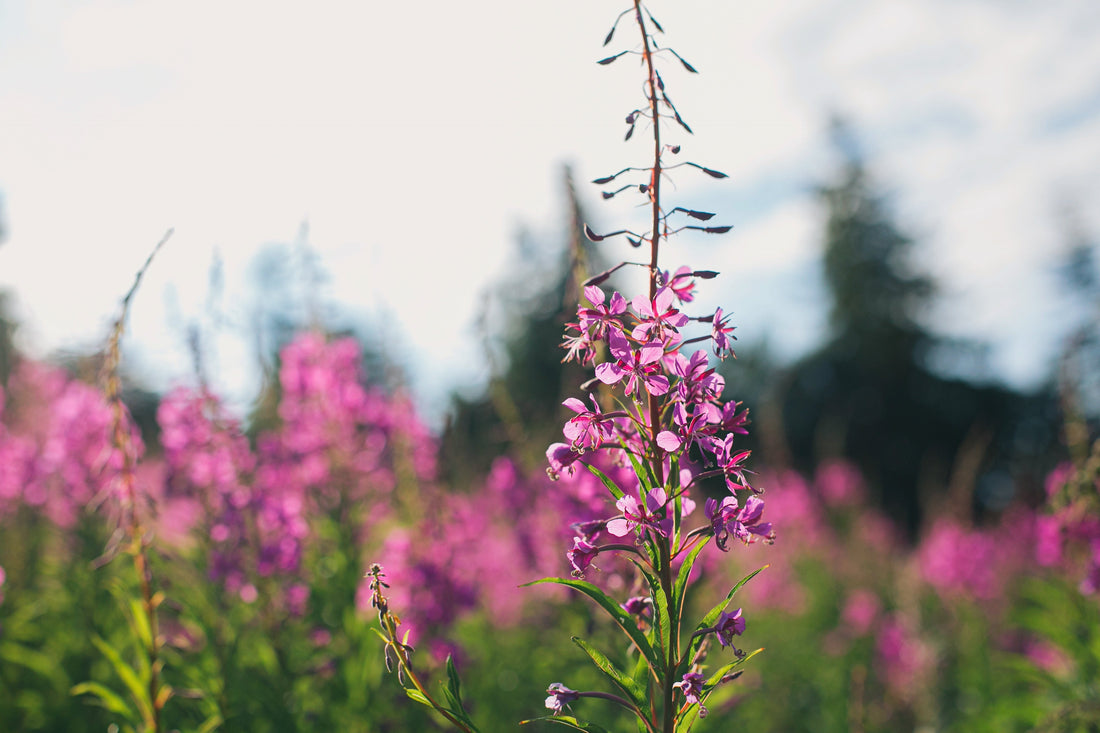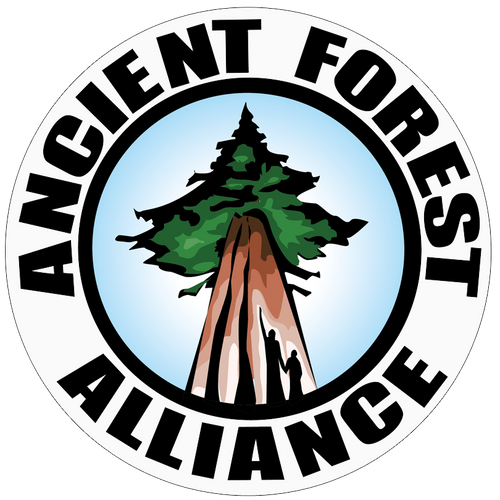
The Pink Torch: Celebrating Canada's Resilient Fireweed
Share
The Pink Torch: Celebrating Canada's Resilient Fireweed
Across Canada, from the charred landscapes of recent wildfires to the sunny edges of highways and meadows, a vibrant pink beacon often rises. This is Fireweed (Chamerion angustifolium, formerly Epilobium angustifolium), a native perennial wildflower that is far more than just a pretty face. It’s a symbol of resilience, a friend to pollinators, and a plant steeped in history and utility.
What Is Fireweed?
Fireweed is instantly recognizable. Picture tall, slender stems (often reaching 1.5 to 3 meters high!) crowned by a dramatic spike of vivid pink to magenta flowers. These blossoms bloom progressively from the bottom of the spike upwards throughout mid to late summer, creating a stunning gradient. The leaves are long, narrow, lance-shaped, and arranged in a distinctive spiral pattern up the stem. They often feature a prominent central vein and sometimes a slightly whitish underside. Once pollinated, the flowers give way to long, slender seed pods that split open to release hundreds of tiny seeds attached to fluffy white down, carried far and wide by the wind – a beautiful sight signaling the approach of fall.
What Does Fireweed Do? Harmful or Helpful?
Far from being harmful, fireweed is a vital ecological hero, especially in disturbed areas. It's a pioneer species. This means it's one of the first plants to colonize bare ground, particularly after events like wildfires (hence its evocative name), landslides, or logging. Its extensive root system helps stabilize soil, preventing erosion. As it grows and eventually dies back, it adds organic matter to the impoverished soil, paving the way for other plants and trees to establish themselves over time. It’s a crucial part of nature’s healing process.
Moreover, fireweed is an incredibly important food source for pollinators. Its nectar-rich blossoms are a magnet for:
- Bees (Honeybees, Bumblebees, Native Solitary Bees): Vital for pollination services.
- Butterflies (especially Monarchs later in migration): Seeking crucial late-summer fuel.
- Moths: Active during dusk and dawn.
- Hummingbirds: Drawn to the bright pink and abundant nectar.
Traditional Wisdom: Fireweed Through the Ages
Indigenous peoples across Canada and Alaska have long recognized and utilized fireweed’s value:
- Food: Young shoots and leaves were harvested in spring and eaten raw in salads or cooked like asparagus. The inner pith of young stems was also consumed.
- Medicine: Infusions (teas) made from the leaves were traditionally used to soothe digestive issues, mouth sores, and skin irritations. Topical poultices made from crushed leaves were applied to wounds, burns, and rashes for their believed anti-inflammatory properties.
- Fiber: The tough outer fibers of mature stems were processed and woven into cordage or even textiles.
- Sweetener: The copious nectar makes fireweed honey highly prized, a tradition continued by modern beekeepers who place hives near large stands.
A Forager's Guide to Fireweed (Ethically & Sustainably)
Fireweed offers delicious and nutritious foraging opportunities, but it must be done mindfully and ethically. Remember: Pollinators First!
What to Harvest & When:
- Young Shoots (Early Spring): When very young (under 15-20 cm tall) and tender. Taste like mild asparagus. Harvest Sparingly – taking too many shoots prevents the plant from growing and flowering.
- Leaves (Spring to Early Summer): Best when young and tender, before the plant flowers heavily. They become tougher as the season progresses. Ideal for tea, salads (young leaves), or cooking like spinach.
- Flower Buds & Blossoms (Mid to Late Summer): Harvest vibrant, freshly opened blossoms and tender buds. Avoid wilted or brown flowers. Prime time is usually late morning after dew has dried.
Sustainable Harvesting Practices (CRITICAL):
- Identify Correctly: Ensure it's truly Fireweed (Chamerion angustifolium). Look for the tall spike of 4-petaled pink flowers and spiral lance-shaped leaves.
- Location Matters: Only harvest from abundant, healthy stands. Never harvest from protected areas, parks (unless explicitly permitted), or small, struggling patches. Avoid roadsides heavily impacted by pollution.
- The Golden Rule: Take 1/3 or Less: Never take more than one-third of the leaves from a single plant. For blossoms, take no more than one-third from any given flower spike. Leave the majority for pollinators and for the plant to set seed.
- Prioritize Pollinators: If bees or butterflies are actively working the blossoms you approach, move on. Find a different plant or cluster not currently in use. Harvesting blossoms removes vital food sources.
- Distribute Your Take: Instead of heavily harvesting one or two plants, take just a few leaves or blossoms from many different plants across a large, robust stand.
- Respect the Roots: This perennial needs its roots to survive winter and regrow. Don't dig roots unless you have specific landowner permission and a deep understanding of sustainable root harvesting (generally not recommended for casual foragers).
Preserving the Bounty:
- Leaves for Tea:
- Air Drying: Bundle small bunches of stems upside down or spread leaves in a single layer on a screen in a warm, dark, well-ventilated place. Dry until crisp.
- Dehydrator: Use low heat (95-105°F / 35-40°C) until brittle.
- Storage: Store whole dried leaves or crumbled leaves in airtight jars in a cool, dark place. Enjoy as a soothing, slightly earthy tea rich in vitamins and tannins.
- Blossoms:
- Drying: Dry whole blossoms gently using air drying or a dehydrator on very low heat. Use dried flowers in teas or as a colorful garnish.
- Fireweed Honey: Steep fresh blossoms in gently warmed honey for several days to weeks, then strain. Creates a uniquely floral honey.
- Jelly/Jam: Cook blossoms with sugar, pectin, and lemon juice for a beautiful pink jelly with a delicate floral taste.
- Vinegar: Infuse blossoms in vinegar for a floral salad dressing base.
- Freezing: Freeze whole blossoms on a tray before transferring to bags for use in smoothies or as ice cube decorations later.
Benefits of Each Part:
- Leaves: Rich in vitamins (especially A and C), tannins (astringent properties), and antioxidants. Primarily used for tea, offering potential soothing effects for digestion and skin. Young leaves add nutrients to salads.
- Blossoms & Buds: Contain nectar, pollen, and antioxidants. Offer a delicate floral flavor and stunning color. Used in syrups, honey, jelly, vinegar, garnishes, and teas.
A Final, Vital Reminder: Share the Bounty
As you admire the breathtaking pink spires lighting up the Canadian landscape this summer, remember the crucial role fireweed plays. It’s a healer of the land, a lifeline for bees, butterflies, and hummingbirds, and a plant woven into the fabric of this country's natural and cultural history.
If you choose to forage, do so with the utmost respect and restraint. Prioritize the needs of the ecosystem and the pollinators who depend on this vital resource. Sustainable harvesting ensures that the "Pink Torch" will continue to flourish, signaling renewal and nourishing life for generations to come. Take only a little, leave plenty for the wild ones, and always tread lightly.
Happy (and mindful) foraging!
Disclaimer: This blog is for informational purposes only. Always be 100% certain of your plant identification before consuming any wild plant. Consult reliable field guides or experts. Foraging is done at your own risk. Be aware of local regulations regarding foraging on public or private land. Consult a healthcare professional before using any wild plant for medicinal purposes.

